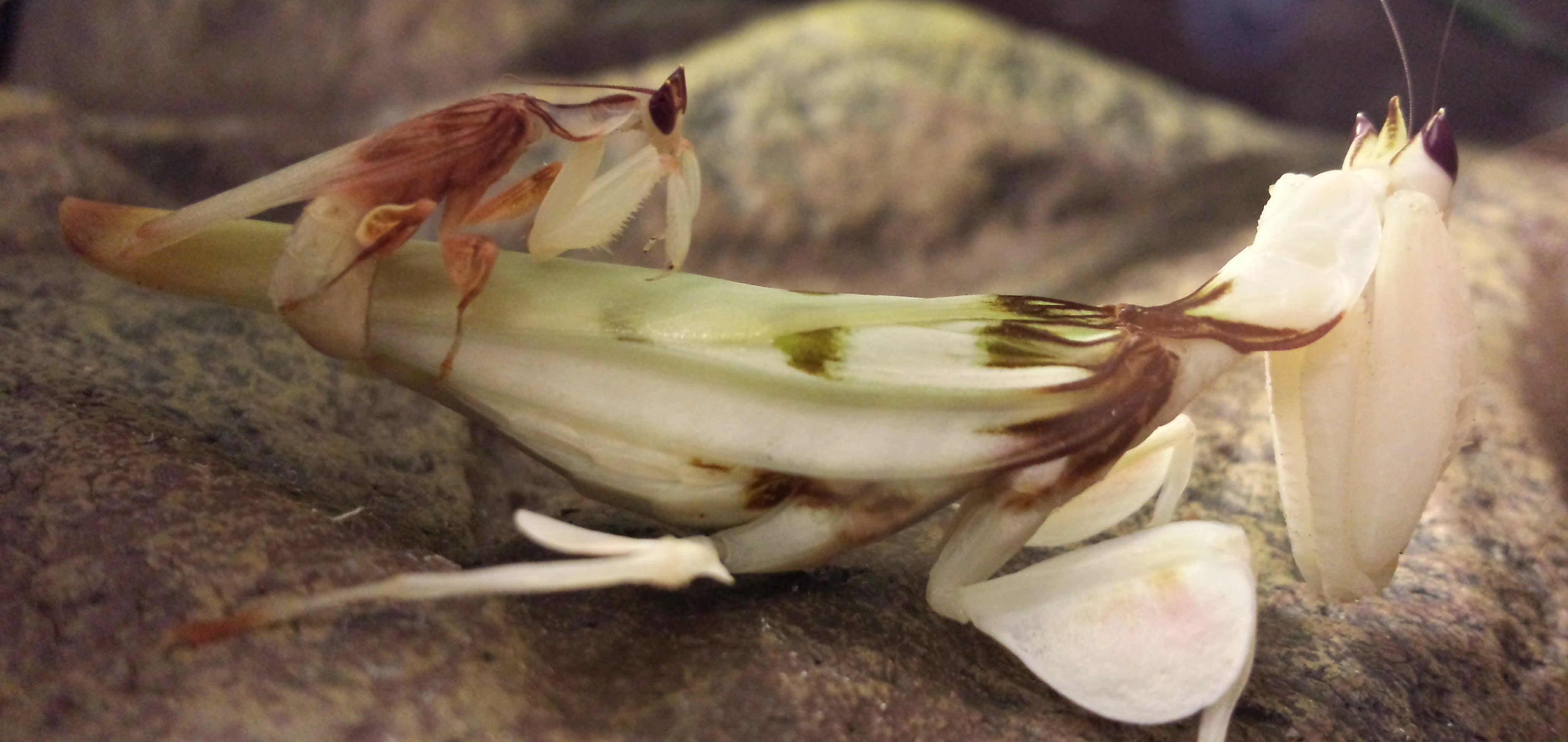Orchid Mantis Caresheet
Housing

The Orchid Mantis (Hymenopus coronatus) should be kept in an enclosure that is at least 3 times as tall as the mantis is long, and at least 2 times as wide as the mantis is long. The gender of your mantis is a very important consideration when deciding on what size enclosure to purchase. This is because as a adult, females can get up to 3 inches long, while males can be less than 1 inch long as an adult.
The enclosure must also have adequate ventilation, and some kind of material on the ceiling of the enclosure which will allow the mantis to hang upside down during molting, as well as an empty space at the top which is at least 2 times the size of the mantis. They can be kept in glass or mesh cages, but enclosures with glass or clear plastic sides and a mesh or screen top are ideal, due to the humidity requirements of this species.
Orchids do best in a living vivarium with live plants and microfauna (e.g., springtails and isopods) who will act as a sort of "clean up crew" by breaking down the mantis's waste and food scraps, thereby reducing the build up of mold and bacteria that can make your mantis sick or even die. You can certainly keep them in temporary enclosures such as mesh cages with silk plants (such as an Orchid Flower, or White Flower) and an easily disposable substrate such as sphagnum moss or just a paper towel; however, if you chose this approach you must be diligent about cleaning the enclosure and replacing the substrate at least once a week, because the humid conditions required for this species will promote the growth of mold and dangerous bacteria without a healthy population of microfauna to help keep it in check.
Temperature & Humidity
Orchid mantises are native to the tropical rainforests of Malaysia, so they generally need warm, humid conditions to thrive. The ideal temperature for an orchid mantis is 80°F to 85°F, but they can tolerate a range between 70°F and 90°F. Humidity should be kept between 60% and 80% relative humidity (RH). Younger nymphs seem to be less tolerant of lower humidity levels than adults. Nymphs should be kept at the higher end of the humidity range, between 60% and 80% RH, otherwise they will have trouble molting successfully. Ventilation is also very important in the nymph stage, and even more important in the later stages of adulthood, as they will become more susceptible to bacterial infections as they age. However, young adult females may refuse to lay ootheca, if humidity and temperatures are too low.
Depending on the amount of ventilation, the enclosure should be given a light misting once a day. Orchid mantises kept in mesh or screen cages should have their enclosures misted twice a day to maintain proper humidity. Not only that, but misting the enclosure also allows the orchid mantis to drink. Most mantises do not like getting sprayed directly, so it is best to try and spray around the mantis, but if you get them a little wet by accident, it is usually no big deal. Use spring water, distilled water, or water filtered by reverse osmosis (RO), but do not use plain tap water.
Feeding
Orchid mantises prefer flying insects throughout their entire lifecycle.
- L1 and L2 nymphs: Should be fed D. melanogaster fruit flies.
- L3 and L4 nymphs: Should be fed D. hydei fruit flies.
- L5 nymph to adult: Should be fed house flies, hover flies, blue bottle flies, butterflies, and moths.
Orchid mantises will really benefit from being fed honey, or a mixture of honey powder and bee pollen at least once a week. You can dust your feeder insects with it by misting them lightly, then pouring the dry powder over the feeder insect. Or, you can wet a toothpick slightly, dip it in the powder, then hand feed the mantis the moist powder from the toothpick.
For additional information about our experience and observations with raising this species, see our Orchid Mantis Blog on the Our Collection page.
For additional information about the Orchid mantis from outside sources, including breeding and ootheca care, please reference the links below:
Orchid Mantis (Hymenopus coronatus) Caresheet – Keeping Insects
Orchid Mantis (Hymenopus coronatus) Caresheet – Mantid Forum
Orchid Mantis (Hymenopus coronatus) Caresheet – Rainforest Fauna

